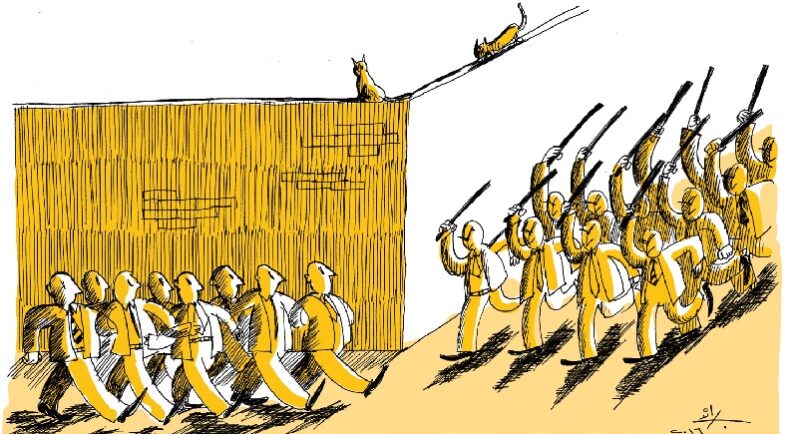Defending Tiran and Sanafir: Khalid Ali Remembers (II)

The Court and its Impressions of the Case and the Pleadings
What mattered to me most was that from the first hearing, the court’s impressions of the case are positive and objective, in contrast to the portrayal of the case in the regime’s media as a media case aimed only at creating a political spectacle. I am a lawyer who always prefers to hold off presenting each document to the courts until the right time based on the course of the dispute. But in this case, I had to make a good impression and convince the court to entertain the requests that I would make from the government’s lawyer. Hence, I deliberately presented most of the documents I possessed to compel the court to hear my entire defense and grant my requests. They included: the Ministry of Defense’s atlas published by the Military Survey Department in 2007, which includes four pages of maps confirming that the islands are Egyptian; copies of all the confidential correspondence of the ministries of defense, foreign affairs, and finance from 1949 and 1950; a copy of the fatwa issued on January 12, 1950 by State Council judge Wahid Raafat, who was the first to call upon Egypt to raise the Egyptian flag over Tiran and Sanafir; and, the book by Finish orientalist Georg August Wallin, who took two trips to the Arabian Peninsula and Sinai in 1845 and 1848 and confirmed that the people living on the islands at that time were Egyptian.
When the court asked me, “where did you get these documents?”, I knew that my first task –namely showing the court the seriousness of my case from the first hearing– had succeeded. Hence, I asked the court to compel the government to provide a copy of the contested agreement and a copy of all the minutes of the joint Egyptian and Saudi committee for demarcating the border between the two countries, which had held sessions intermittently between 2010 and the signing of the agreement on April 9, 2016. I also asked the court to compel the government to provide all the photocopies that I presented regarding the correspondence between the ministries and Wahid Raafat’s fatwa. The court issued a decision adjourning the case and compelling the government to provide all the documents I had requested.
The following day, the events of the hearing –particularly my presentation of the armed forces’ atlas containing pages confirming that the islands are Egyptian– dominated the headlines of the national and major newspapers. On that day, many passersby stopped me in the street to ask me not about the islands being Egyptian, but about the veracity of the [news about] the Ministry of Defense’s atlas that includes four pages about the islands. At that point, I also knew that the public had begun dealing with the case with the seriousness that I had hoped for in order to secure their continuing trust, and hence their continuing support for us in this dispute.
The Legal Strategy in the Court of Administrative Justice
While the case was in the Court of Administrative Justice, the government’s lawyer was in an unenviable position. Although the court obliged him to provide the documents we had requested, the government refused to supply it with any. The only defense that the lawyer could present was some peremptory pleas, such as that we had no standing to file the case, or that the court had no jurisdiction to examine or rule on the case because agreements fall under the sovereign acts doctrine. This strategy prevented us from viewing the government’s alleged documents and responding to and refuting them, on one hand; on the other hand, the government’s lawyer stuck to that doctrine and called upon the court to apply the same grounds that it had issued in the case of the challenge to the maritime demarcation agreement with Cyprus; grounds that deemed said agreement a sovereign act.
Our strategy centered on presenting all the documents that prove the territory Egyptian, and calling upon the court to interpret the sovereign acts doctrine within the bounds of the documents we presented and the constitutional texts that prohibit the president, Parliament, and even referendums from ceding any Egyptian territory. From this perspective, any act contravening the Constitution –even one that could be classified a sovereign act– is subject to judicial review. We asked the court to determine the territory’s legal status –is it Egyptian or not?– before deciding on the other pleas, and that is what occurred. The court confirmed that the territory is Egyptian, and then voided the agreement for comprising a cession by a party that does not have the right of ownership and authority to cede it to a party not entitled to it, in contravention of the Constitution’s texts.
The Legal Strategy in the Supreme Administrative Court
The media reported that President Abdel Fattah el-Sisi, in “the Meeting of the Egyptian Family” held with some Egyptians in the presidential office before the Court of Administrative Justice issued its ruling, said that the islands are not Egyptian and that he did not want to talk about the issue again. He claimed that he had asked all state institutions and they had all told him that the islands are not Egyptian. He concluded his speech by saying that his mother had always advised him “not to take someone else's property”, and that the islands are a trust that he had returned to its owner, Saudi Arabia.
However, after the Court of Administrative Justice’s ruling annulling the agreement, the president said in a televised interview, “why don’t you [i.e., the president’s legal team] present the documents to the people and the court?”. This was a declaration of a change of strategy for the government. A journalist and member of parliament published a book claiming that the islands are Saudi and published some excerpts with flimsy content; and, the State Lawsuits Authority presented a number of documents wherein it claimed that the islands are not Egyptian, that Egypt does not exercise any sovereignty rights over them, and that Egypt only had the rights to administer it under an agreement with Saudi Arabia. Consequently, we had to develop our defense strategy: we continued presenting new documents confirming that the islands are Egyptian, including a copy of the Egyptian Survey Authority’s 1912 map of Egypt showing the islands to be Egyptian territory 20 years before Saudi Arabia’s establishment. We we also began discussing and refuting all the documents presented by the government. We asked the court to exclude all the photocopies presented by the government.
We also showed that the government had presented ten contradicting narratives to explain Egypt’s presence on these islands: the islands were lent to Egypt; they were rented to Egypt; Saudi Arabia ceded them to Egypt for 90 years; they were annexed to Egyptian territory; they were seized; they were occupied in accordance with a prior agreement with Saudi Arabia; Egypt occupied them unilaterally and Saudi Arabia welcomed the occupation; Egypt has administration rights and not sovereignty rights; a special arrangement between Riyadh and Cairo put them at Egypt’s disposal; or, they are located in Saudi Arabia’s territorial waters and the country granted them to Egypt as a trust to protect. The government did not present any documents between Egypt and Saudi Arabia pertaining to any of these contradictory narratives. It insisted in court that the islands are not Egyptian, but failed to explain why we raised the flag over them, fought for them, and practiced by ourselves all forms of sovereignty over them throughout these decades.
We also showed the court the manipulation of documents via changes made to the curricula for the sixth grade of primary school and the first grade of secondary school. In the 2015-2016 study year, the curricula had presented these islands as Egyptian nature reserves. After the Court of Administrative Justice’s ruling on June 21, 2016, the relevant sections were removed from the new curricula for the 2016-2017 study year.
The Egyptian National Library and Archives Scandal
The Egyptian National Library and Archives (NLA) retains a copy of every government document, with especial attention given to those related to territory and the Arab-Israeli conflict. The NLA’s experts and scholars have played a prominent role in raising the Egyptian people’s awareness of their heritage and rights. The research contributions that they have published have had a large impact. Among these scholars is Dr. Sabry al-Adly, who published a study on Tiran and Sanafir that included copies of a number of the documents it drew upon.
During the case, we asked the court for permission to extract some documents from the NLA. The court granted it, so I went to the NLA and legally submitted the permit which they promised to implement. Then, one day before the hearing, they surprised me by claiming that the search was still underway. They asked me to come in early before the hearing. I did so and met the NLA’s director, Nivin Mahmud, who repeated the same answer. Hence, I went to the hearing without having received any documents.
However, the surprise was that the NLA had granted the government’s lawyer a confidential document, namely a letter exchanged between the Ministry of War and Ministry of Foreign Affairs in 1928. The former had asked the latter whether the Tiran islands were identified in the ministry’s records as Egyptian territory. Of course, the Ministry of Foreign Affairs responded that it had no records, for it is well known that those records were with the Ministry of Finance. During King Farouk’s rule, a decision was issued deeming Egypt’s borders to encompass every area from which taxes are collected. The State Lawsuits Authority tried to use this response as evidence that the islands are not Egyptian, so we clarified that the Ministry of Foreign Affairs’ response did not indicate that the islands are not Egyptian, but that the ministry simply had no records in this regard. We also pointed out that this correspondence occurred four years before Saudi Arabia’s establishment and explained King Farouk’s aforementioned decision.
We presented a book issued by the Ministry of Finance in 1945, which included a map of Egypt and an index both showing these islands as Egyptian. We also presented a letter sent by the Ministry of War to the Ministry of Foreign Affairs in 1949 asking the same question about the islands. The Ministry of Foreign Affairs had contacted the Ministry of Finance, which responded that the islands are Egyptian, and then conveyed this response to the Ministry of War. These are the letters that I had submitted a request to the NLA to obtain a copy of. I was not amazed that the NLA granted the State Lawsuits Authority the documents that it needed and that support its perspective, even without a permit from the court, but the strange thing was that it withheld the rest of the documents that we requested. I obtained another adjournment from the court and a new permit for the same documents.
I went to the office of the president of the [General Authority for the NLA] Mahmoud Dabh, and I explained to him that the NLA is biased and withholding documents. He informed me that he had stamped the permit to implement what the law requires, and that the NLA’s director was responsible for implementation. He summoned her to his office, and she and I had the strangest discussion about her refusal to implement the permit based on flimsy excuses. The president simply apologized to me and told me that I have a right to report the incident against me, so I headed to the police department and filed a complaint against him and the NLA’s director. In the following hearing, the State Lawsuits Authority brought a letter stating that the search for the documents we requested was still underway.
This bitter incident reflects a great crisis, namely the denial of the Egyptian people’s right to know, and to freedom of information to an extent that puts our country’s territory at risk. At a time when we can view all the British National Archives’ documents online, buy the ones we want, and have them posted to us, the Egyptian NLA not only withholds these documents from us and the court but also disastrously attempts to give the government the upper hand. It thereby undermines equal opportunity in litigation and destroys its own neutrality, as well as its academic and professional independence.
The Fight is Not a Single Case and We Will Not Win Via a Knockout Blow
We mentioned earlier that 13 cases were filed calling for the annulment of the agreement. Eleven of them are still with the Board of State Commissioners; it has not provided its opinion on them yet, and no rulings have been issued. The first two cases were merged into one case, wherein the Court of Administrative Justice issued its ruling annulling the agreement. This ruling spawned twelve secondary legal disputes, of which there is no room to detail here. Thus far, two rulings have been issued against us by an incompetent court, seven rulings have been issued in our favor, and no rulings have been issued yet in four of the cases – all in addition to the main ruling. Hence, this fight will be decided not by a knockout but by the points. Thus far, we have won approximately 90% of it, and perhaps we can expect new disputes to be born during the coming days or weeks.



